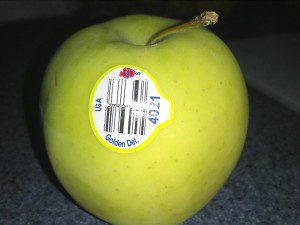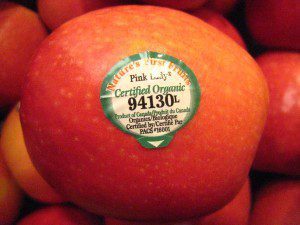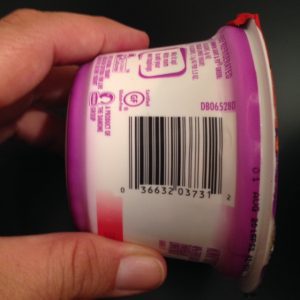Have you ever wondered what all of those little stickers on your apples, tomatoes, and other produce were for? Or the barcode on the everything else at the grocery store? Surprisingly, they actually contain information that you might want to know!
The four and five digit codes on produce stickers are to help make checkout more efficient, so that the cashier can look up the item and charge the correct price. These PLU’s, or Price Look Up codes, help to eliminate the need for guessing what the item is, but they also provide information that a consumer may use also.
If your apple has a 4 digit PLU, it is conventionally grown – not organic. These may also appear as 5 digit codes, with the first digit being a zero, though this is not common.
If the item has a 5 digit PLU number that starts with an 8, it is genetically modified (GMO), and a 5 digit code that starts with a 9 is organically grown.
While this is good information to know, it is also important to note that many items will not have these labels as they are not required, and are an option that can be used as a convenience for stores. They weren’t intended to be used by customers. I was unable to find any produce with the GMO identifying PLU, but this is a hot topic and GMO is not something that many suppliers want to identify!
If organic and/or GMO-Free produce is important to you, be sure to look for labels that state that the item is certified USDA organic. Also good to note is that organic items are also GMO-free, but that GMO-free does not necessarily mean organic!
Non-produce barcodes, or UPC’s (Universal Product Code) on other products also contain some useful information, but they are most beneficial for retailers. They do not contain prices, but simply identify the individual product so that the retailer can track sales or assign a price in their point of sale system.
The first 6 digits represent the manufacturers identification code, including the country that the company is in. For example, U.S. and Canadian companies ID’s begin with 00 to 13, and Chinese ID’s begin with 690 to 695. This can be a bit misleading if not interpreted correctly though, as the company location is not necessarily the same as the manufacturing location! The last 6 digits are the actual product code and identify the particular item.
This barcode translates to, “I am made by Dannon, a company in the USA, and I’m 5.3oz container of Dannon Light & Fit Strawberry Greek Yogurt!” Though the company is identified as residing in the USA, the product could have been manufactured elsewhere. However Dannon’s website notes that they produce their yogurt at factories in Ohio, Texas, Utah, and Oregon.
SO, do YOU pay attention to what’s in your label? Or are you going to start?















All good information. I knew about the conventional and organic codes on produce but I didn’t know about the GMO label. I haven’t seen one either. I know that zucchini and squash are common GMO produce so I try to purchase these as organic to avoid them being GMO. Thank you for sharing.